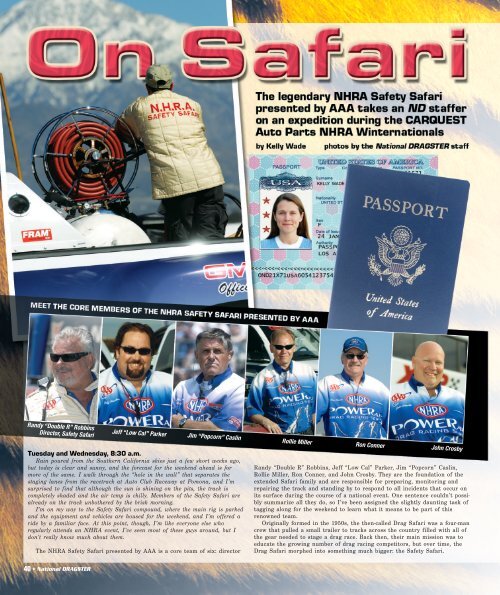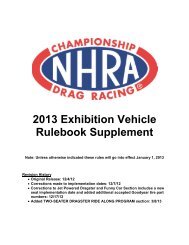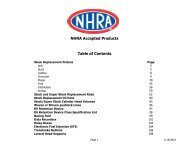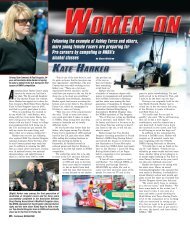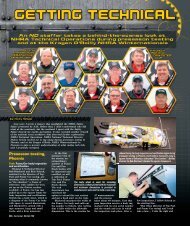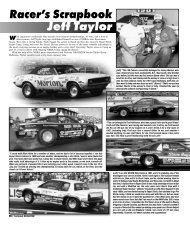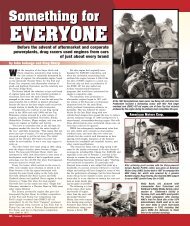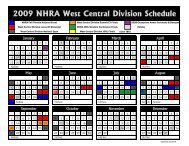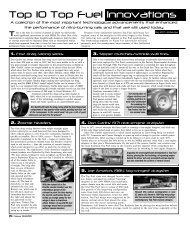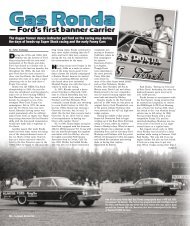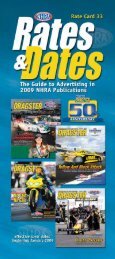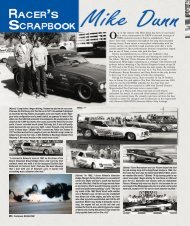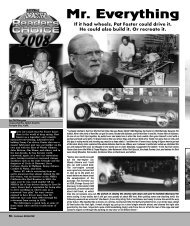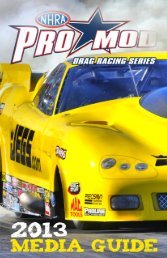You also want an ePaper? Increase the reach of your titles
YUMPU automatically turns print PDFs into web optimized ePapers that Google loves.
Randy “Double R” <strong>Robbins</strong><br />
Director, Safety Safari<br />
Jeff “Low Cal” Parker Jim “Popcorn” Caslin Rollie Miller Ron Conner John Crosby<br />
Tuesday and Wednesday, 8:30 a.m.<br />
Rain poured from the Southern California skies just a few short weeks ago,<br />
but today is clear and sunny, and the forecast for the weekend ahead is for<br />
more of the same. I walk through the “hole in the wall” that separates the<br />
staging lanes from the racetrack at Auto Club Raceway at Pomona, and I’m<br />
surprised to find that although the sun is shining on the pits, the track is<br />
<strong>com</strong>pletely shaded and the air temp is chilly. Members of the Safety Safari are<br />
already on the track unbothered by the brisk morning.<br />
I’m on my way to the Safety Safari <strong>com</strong>pound, where the main rig is parked<br />
and the equipment and vehicles are housed for the weekend, and I’m offered a<br />
ride by a familiar face. At this point, though, I’m like everyone else who<br />
regularly attends an <strong>NHRA</strong> event, I’ve seen most of these guys around, but I<br />
don’t really know much about them.<br />
The <strong>NHRA</strong> Safety Safari presented by AAA is a core team of six: director<br />
Randy “Double R” <strong>Robbins</strong>, Jeff “Low Cal” Parker, Jim “Popcorn” Caslin,<br />
Rollie Miller, Ron Conner, and John Crosby. They are the foundation of the<br />
extended Safari family and are responsible for preparing, monitoring and<br />
repairing the track and standing by to respond to all incidents that occur on<br />
its surface during the course of a national event. One sentence couldn’t possibly<br />
summarize all they do, so I’ve been assigned the slightly daunting task of<br />
tagging along for the weekend to learn what it means to be part of this<br />
renowned team.<br />
Originally formed in the 1950s, the then-called Drag Safari was a four-man<br />
crew that pulled a small trailer to tracks across the country filled with all of<br />
the gear needed to stage a drag race. Back then, their main mission was to<br />
educate the growing number of drag racing <strong>com</strong>petitors, but over time, the<br />
Drag Safari morphed into something much bigger: the Safety Safari.<br />
40 ✦ National DRAGSTER
The <strong>com</strong>pound is bustling, and as I set out to find the<br />
boss, “Double R,” I feel more than a couple curious, sidelong<br />
glances my way. For a moment I question my<br />
presence here. I’m not sure I belong among these people<br />
who hold so much responsibility in their hands. My job is<br />
serious, yeah, but not this kind of serious. These guys are<br />
prepared to help save a life if needed, and I’m prepared<br />
to — well, I’m prepared to write stuff down.<br />
“Well, hello dear,” says “Double R” with a <strong>com</strong>fortable<br />
Kentucky drawl, and I’m instantly at ease. He introduces<br />
me to Miller, Crosby, “Low Cal” (aka Cal), and<br />
“Popcorn” before I greet Conner, who, at the soggy Seattle<br />
event last season, explained to me how the Safety Safari<br />
handles rainy weather, which I’m grateful for because it<br />
doesn’t look like I’m going to see the massive jet engine<br />
dryer or the water sweeper at all this weekend.<br />
This is a diverse group with one thing in <strong>com</strong>mon:<br />
They love what they do. In testimony to this, most have<br />
been around a long time. “Double R” has been in his<br />
position for more than 20 years, and both “Popcorn”<br />
and “Cal” closely follow in tenure. Amazingly, part-timer<br />
Rowland Hall has been in the mix for 34 years. I easily<br />
surmise that longevity <strong>com</strong>es naturally for this group.<br />
“We’ve been here since last Wednesday getting<br />
equipment ready and doing vehicle maintenance,” said<br />
Miller as we headed back toward the starting line. Track<br />
prep began on Monday, and the process usually begins<br />
with the track scrubber driven by Crosby’s wife, Robin.<br />
Once the track is clean, the layering begins.<br />
“You can’t really do the same thing on each track,”<br />
explained “Cal.” “They have different characteristics determined<br />
by weather, humidity, and how much racing they do<br />
on the track. Our goal is to make each track consistent.”<br />
The clean surface is treated with a layer of VHT, a<br />
sticky, sweet-smelling chemical <strong>com</strong>pound that works like<br />
glue. Layers of rubber are applied using a steel machine<br />
pulled by a tractor and powered by a small-block 350-cid<br />
Chevy engine that rotates three slicks — used tires<br />
donated by fuel car teams — in the opposite direction,<br />
laying down hot rubber and emitting a piercing squeal.<br />
The tire drag is followed by a layer of white VHT<br />
powder that’s “broomed in” by hand before the tire drag<br />
machine is sent out again. The following day, they’ll<br />
wash the track again and spray the liquid VHT traction<br />
<strong>com</strong>pound as the final step before race day.<br />
The team walks onto the track and checks out the<br />
work. They aren’t always happy at this stage of the<br />
game, though. “Sometimes, it’s tough when you get a<br />
spot that doesn’t want to adhere to rubber,” said Miller.<br />
“I’ve never seen a perfect track. You can do the best you<br />
can do, but it’s never going to be perfect.”<br />
The next day I arrive at 7 a.m., and Miller is in the<br />
sweeper. I’m a little disappointed. I’d hoped to ride along<br />
this morning, but once the sweeper is in motion on the<br />
track, it can’t stop; otherwise, it’ll tear into the surface<br />
(Right) The starting-line crew, under the<br />
direction of <strong>NHRA</strong> Chief Starter Rick<br />
Stewart, left, brushes in absorbent<br />
powder to clean up oil. (Above) The<br />
team on Emergency Truck 1 assists the<br />
starting-line crew with the dreaded job<br />
of scraping the surface to fill bald spots<br />
and evenly distribute heated rubber.<br />
that they’ve been<br />
smoothing. I make my<br />
way to the <strong>com</strong>pound and<br />
find “Cal” and Conner<br />
preparing to spray the<br />
track with liquid VHT.<br />
Three barrels of VHT<br />
are loaded into the truck,<br />
and Miller and Conner<br />
lift a small Briggs &<br />
Stratton motor on top of<br />
one. A hose connects the<br />
motor and barrel to an<br />
aluminum T-bar with a<br />
series of nozzles.<br />
“Double R” hops on<br />
the tailgate and grabs the<br />
T-bar, Conner starts the<br />
small motor atop the<br />
barrel, and we head down<br />
the track. We spray up<br />
and down each lane from<br />
guardwall to guardwall,<br />
emptying and switching<br />
barrels as we go, and<br />
after our final pass, the<br />
track has a glossy sheen.<br />
“It looks real good,” says<br />
Miller, and “Double R”<br />
turns off the sprayer at<br />
the scoreboards.<br />
Thursday, 7 a.m.<br />
First day of the event<br />
Crosby is on the red<br />
tractor dragging the hollowed slicks on the front to lay<br />
down fresh rubber, something he does two hours before<br />
the event each morning. Conner is filling the sticky pig, a<br />
blue barrel that hitches to the back of a golf cart and<br />
sprays VHT through a long row of nozzles attached to the<br />
back. Once the sticky pig is filled, we begin to spray. This<br />
is the final step before the event begins, and the Safety<br />
Safari has done all that’s within its power to make the<br />
track as safe and ready for record-setting runs as possible.<br />
I’m on Emergency 1 today, the truck closest to the<br />
starting line. Each station is staffed by workers who have<br />
used vacation time from everyday jobs to be here. I meet<br />
the Emergency 1 boss, Terry Coffield, who introduces me<br />
to Willy Stambaugh, Tom Balzarini, Gary Bush, Tom<br />
Kennedy, Ray Conklin, and Jeff Tolstead. They’re all<br />
happy to see one another, and Balzarini jokingly says,<br />
“It’s the beginning of the year. About Seattle, we’ll all<br />
hate each other.”“<br />
Hall and Roger Brown, a fire-equipment<br />
salesman from Kansas, are also at the starting line<br />
as the day begins — they ride quads equipped with<br />
everything needed to tow cars<br />
off the track — and <strong>NHRA</strong> Chief<br />
Starter Rick Stewart, who<br />
manages the starting-line crew<br />
and works closely with the<br />
Safety Safari, is in position as<br />
the first pair of cars roll up to<br />
the starting line.<br />
Division 7 Director Mike Rice,<br />
the radio monitor for this event,<br />
called from the tower to inform<br />
us that he saw oil on the track. A<br />
truck swept in rice-hull ash, Safari<br />
members <strong>com</strong>bed the track on<br />
foot picking up stray pieces, and<br />
Miller, with me in the passenger<br />
seat, swept after them. A few<br />
minutes after our return, another<br />
oildown was reported, and we<br />
repeated the process.<br />
Days before the first pair of cars roll from the staging lanes to the starting line, the Safety Safari<br />
is hard at work. (Above left) “Double R” sprays a shiny layer of traction <strong>com</strong>pound on the<br />
surface. “A lot of people don’t realize what all goes on before a race even starts,” said Conner.<br />
(Above right and below) Before and during the event, Conner and “Cal” let me tag along as they<br />
towed the sticky pig, a barrel used to spray additional VHT on the surface as required.<br />
Midway through the morning, Stewart and the<br />
starting-line crew repaired a few bald spots. Stewart<br />
spread powder with a lawn seeder and sprayed VHT<br />
with a hand-sprayer. He requested a “two-lap pass” with<br />
the red tractor, and Robin Crosby did it.<br />
Later, Top Alcohol Funny Car driver Dan Dickey<br />
got out of the groove and hit the wall. Unfortunately,<br />
this was the part of the weekend when I learned the<br />
hard way that if you aren’t in the truck when it’s<br />
rolling, you’re not going anywhere. I began to half-run,<br />
half-skip toward the already moving sweeper, but then<br />
I remember that Miller couldn’t stop, so I watched<br />
from a distance.<br />
Before the Pro session, the starting-line crew and<br />
Emergency 1 scrape the track. It’s a well-orchestrated<br />
ballet. Teams of two work together, one pushing a longhandled<br />
scraper while another heats the rubber with a<br />
torch. They use the excess rubber to fill in bald spots<br />
and smooth the first 50 feet. They then gradually work<br />
their way out farther as the weekend progresses. John<br />
Crosby drags with the tractor to finish the work.<br />
The Pro session begins, and the radio traffic has<br />
increased. A short while into the session, the monitor<br />
radios, “He still going, ‘Cal?’ ” and “Cal,” from the top<br />
end, responds “He might be going long — yep, we got one<br />
in the sand.” Miller explains that the team at the top end<br />
will pull the car out and fluff the sand, then smooth it<br />
before finishing with light ripples. There is a science to<br />
everything that they do.<br />
“I’m going to need you down here in the left lane,<br />
Rollie,” says “Cal.” Miller takes off into the swarm of<br />
crew chiefs testing the stickiness of the track with the soles<br />
of their shoes. He honks, and they give way. There are<br />
multiple trucks on the scene, sweepers, tractors, quads,<br />
and people on foot. It looks like magic the way they get<br />
out of one another’s way at the last second, but Miller<br />
tells me that in addition to the radio, they use signals, eye<br />
contact, and nods to <strong>com</strong>municate with one another.<br />
At the end of the day, most of the crew heads out to<br />
to page 42<br />
March 7, 2008 ✦ 41
● On Safari from page 41<br />
dinner and to rest, but some<br />
stay behind to prep the track<br />
for the next day.<br />
Friday, 7 a.m.<br />
Second day of the event<br />
“Double R” gives me<br />
instructions for the day. “Now,<br />
stay in the truck if something<br />
happens,” he says and<br />
introduces me to my new<br />
office in the passenger seat of<br />
Truck 2. Donald “Doc” Day, a<br />
chiropractor from Colorado<br />
who has been on Safety Safari for 15 years, introduces<br />
the Emergency 2 crew. We’re stationed just past the<br />
scoreboards.<br />
Phil Bertuglia is an active-duty Air Force family<br />
man, Mark and Cindi Adams are a married couple from<br />
Denver who met in the fire service and have six<br />
children between them, Darrell Goodwin is a building<br />
contractor from nearby Arcadia who loves to surf, and<br />
Donnie Butts, a stuntman from California, drives a<br />
second scrubber at this end of the track.<br />
Mark Adams, who is also the Division 5 safety<br />
coordinator, points out the tools on the truck. A large<br />
tank holds Cold Fire, a chemical mixed with water used<br />
to suffocate fire. There are fire extinguishers, a wheel<br />
dolly, and the Hurst tool, a large and heavy cutter<br />
<strong>com</strong>monly known as the Jaws of Life.<br />
Racing begins, and I’m talking to Joe Gaudy, a parttime<br />
Safari member whose job for the weekend is opening<br />
a gate as quickly as possible to allow Truck 2 to respond<br />
or to let a slow car through. In the middle of our conversation,<br />
Gaudy and Mark Adams bolt to the track. “Doc”<br />
explains that there was a call on the radio about possible<br />
fluid on the surface. They are always on their toes.<br />
“It’s interesting how you can bring a team together a<br />
few times a year and choreograph it so well,” says Mark<br />
Adams upon their return. “We know what we’re each<br />
going to do in a situation, and it’s almost natural<br />
because of how many times we’ve done it. ‘Double R’<br />
likes the idea of the same people doing the same things,<br />
and it’s good for the drivers; they know what to expect.”<br />
No one hesitates when they hear, “We got oil.” Cindi<br />
Adams is in her position on the tailgate with a bag of<br />
rice-hull ash, and Mark Adams and Bertuglia are on<br />
42 ✦ National DRAGSTER<br />
Emergency Truck 1 boss Terry Coffield, left, and tow<br />
master Rowland Hall were among the many Safari<br />
members kind enough to show me the ropes.<br />
either side with brooms.<br />
Gaudy opens the gate, and<br />
“Doc” quickly drives<br />
through. Once on the track,<br />
“Doc” stops the truck and<br />
gets out. He twists his feet<br />
back and forth on the<br />
surface, feeling for oil that<br />
the eye can’t see, and he<br />
and another Safari member<br />
stand as markers at the<br />
beginning and end of the<br />
spill while cleanup begins.<br />
Back at camp, the crew<br />
slips into heavy fire suits and<br />
helmets for the Alcohol and<br />
Pro classes, and I join Conner trackside at 1,000 feet.<br />
Conner watches the cars as they race toward the<br />
finish line. He’s looking for any<br />
kind of debris or oil, and his<br />
intense stare as the cars race past<br />
is followed by a swift hop over the<br />
guardwall and a scrutiny of the<br />
right and left lanes. Each time,<br />
the observers give one another an<br />
“all clear” wave before taking<br />
position for the next run. After<br />
Doug Herbert’s dragster heads<br />
toward the centerline and ends up<br />
in the sand trap, Conner calls me<br />
out to the track. “See the tire<br />
tracks,” he asks pointing to the<br />
zigzag lines. “That gives us an<br />
idea where to look for oil.” He and<br />
several other trackside observers<br />
do the twisty-foot dance, looking<br />
for the precise beginning and end<br />
of any oil that may have escaped<br />
Herbert’s car.<br />
After a pair of Funny Cars<br />
race by, Conner goes to the track<br />
and locates a patch of oil that<br />
was visibly undetectable. Conner<br />
says, “I didn’t see anything, but<br />
the way the car acted, I thought<br />
I’d better look.” Track scrubbers,<br />
the sweeper, and the tractor are<br />
deployed. Experience is<br />
invaluable in this position.<br />
(Above) When fire flared from Cruz Pedregon’s Funny Car, the Safety Safari was on the<br />
scene before the car even came to a <strong>com</strong>plete stop. “The process is simple,” said<br />
“Cal” of responding to such an incident. “Make sure the driver’s okay, then take care<br />
of the car.” (Right) “Doc,” formerly the Division 5 starter and now the full-time<br />
Emergency Truck 2 driver, was a gracious host along with the rest of his team.<br />
Saturday, 7 a.m.<br />
Third day of the event<br />
Randy Jenkins, a married<br />
father of two who has been a<br />
paramedic with the Houston<br />
fire department for 30 years,<br />
shares the responsibility of<br />
driving Truck 3 with “Cal.” We<br />
watch the cars slow to make the<br />
bend at the top end before<br />
<strong>com</strong>ing to a stop a few feet<br />
beyond where we are parked. In<br />
addition to Jenkins, I meet Tim<br />
Glasco, of Decatur, Ala.; Carol<br />
Altrichter, a trauma center<br />
nurse from Minnesota who has<br />
been on the Safari for more<br />
(Above) The big red tractor, usually driven<br />
by Crosby, is equipped with a large brush, a<br />
“box” that consists of a row of tires for<br />
dragging down rubber, and vats of traction<br />
<strong>com</strong>pound that the tractor can spray from<br />
the front with the squeeze of a lever.<br />
(Below) Miller drives the sweeper truck, a<br />
regenerative air sweeper that collects the<br />
oil-absorbing rice-hull ash, debris, and<br />
water from the track. The 110-galloncapacity<br />
hopper must be emptied of debris<br />
periodically throughout the event.<br />
than 20 years; Joe Ward, of Topeka; Ernie Martin, a<br />
construction inspector who has been part of the team as<br />
long as Altrichter; Dave Caslin, a paramedic ER nurse<br />
and EMS coordinator for the event who is also “Popcorn’s”<br />
son; and Houston firefighter Jimmy Ledbetter.<br />
Lonnie Bevens, the top-end director responsible for<br />
supervising the turnaround crew, and Rick Sumrall, a<br />
machinist who has a lifetime full of racing behind him,<br />
direct the cars as they exit the track. The hard-working<br />
turnaround crew pushes cars off the track and rolls the<br />
parachutes. Bob Marrazaz, Jerry Pascoe, Bill Lager,<br />
Ricky Dearing, Steve Grimes, and Jeff Newsome are a<br />
jovial bunch, and Pascoe tells me that like everyone else,<br />
“we all have real jobs, but this a fun getaway for us.”<br />
Sumrall, a well-respected man, says, “Feels like I’ve been<br />
out here forever. I keep <strong>com</strong>ing out here for the people.”<br />
Glasco and Jenkins check the equipment before the<br />
first pair fires up. Truck 3 has<br />
the same safety equipment as<br />
Truck 2, but the food doesn’t<br />
appear to be quite as gourmet. I<br />
spy a large tub of cheeseballs<br />
being passed around.<br />
A tray of cinnamon rolls is<br />
dropped off. “From V. Gaines,”<br />
Altrichter tells me. “He sends<br />
something at every race, usually<br />
cookies.” Gaines isn’t the only<br />
appreciative racer. Later, Super<br />
Comp racer Robert Broguiere<br />
sends over ice-cold chocolate milk<br />
from his family’s dairy. There are<br />
a few other notoriously kind and<br />
grateful drivers mentioned,<br />
including Hillary Will, Jerry<br />
Toliver, and Max Naylor.<br />
“Cal” is behind the wheel of<br />
Truck 3. With one eye on the<br />
track, he explains that the parttime<br />
crew changes at different<br />
events. Part-timers are regional<br />
and often work at tracks in<br />
their respective divisions. He<br />
tells me that full-time Safari<br />
members James “Buggy”<br />
Parker, Tim Rasmussen, and<br />
Johnny Moto are always<br />
around to help, and Dana<br />
Bisbee and Chris Hill expertly<br />
handle electronics and staging, respectively. [Director<br />
of Emergency Medical Services] Dan Brickey is also a<br />
key player. “Each person is important,” said “Cal.”<br />
“Think of the different departments as part of a gear,<br />
like the inside of a clock. Every piece needs to run<br />
right to keep the correct time.”<br />
“Cal’s” colorful description <strong>com</strong>es to an abrupt halt,<br />
and he radios, “Looks like he’s going into the sand;<br />
monitor.” He shifts into drive, and we race out of position<br />
and pull up next to the sand trap just as Funny Car<br />
new<strong>com</strong>er Bob Tasca III bumps to a stop on “the beach.”<br />
Everything happens lightning fast: Tasca is out of the<br />
car, and the nose of the body is quickly dug out by the<br />
Emergency 3 crewmembers, who are cumbersomely attired<br />
in full fire gear. They lift the body and place it to the side,<br />
and the chassis is hooked to tow straps and pulled<br />
out before I even have a chance to write down a<br />
word of what I’m seeing. My head is spinning<br />
while several crewmembers are quickly evening out<br />
the sand. “We don’t want any ruts,” says “Cal”<br />
calmly as he climbs back into the driver’s seat.<br />
“That could cause a car to launch.” All I can do is<br />
nod my head.<br />
Soon after, Cruz Pedregon’s Funny Car veers<br />
to page 44
● On Safari from page 42<br />
toward the wall on fire. We speed onto the track, and<br />
several Safari members jump off the back of the truck<br />
with blanket bottles and fire extinguishers with long<br />
wands that reach beneath the flames. Pedregon is out of<br />
the car and pacing.<br />
“Make sure the fire is out,” he says as Poplin tries to<br />
examine his nose and mouth to determine whether or not<br />
he inhaled any fire. “Did we get a time slip?” asks<br />
Pedregon. “How about the body, does it look bad?”<br />
Pedregon is high on adrenaline, and although his pacing<br />
appears to be making the job of the Safety Safari a little<br />
difficult, within a few short minutes the car is off the<br />
track and a massive cleanup is taking place. Even the<br />
boss, “Double R,” is pushing a broom. A few minutes<br />
later, the track is cleared and ready to go.<br />
Sunday, 9:30 a.m.<br />
Final day of event<br />
Miller asks what my plan for the day is, and after a<br />
brief discussion, it’s decided that I should spend the<br />
first few Pro rounds at Emergency 2 and 3. “You<br />
should see what happens at the starting line after the<br />
final round,” he says. “Everything goes into different<br />
trailers and gets packed up in a hurry, and what took<br />
four or five days to set up <strong>com</strong>es down in about an<br />
hour and a half.”<br />
I head down to Emergency 2 for round one, and during<br />
the first round of eliminations, Tony Pedregon’s Funny Car<br />
explodes into flames, and debris rains onto the track. I’m<br />
sitting next to “Doc” in Truck 2, and as he shifts the<br />
idling truck into drive, my hand flies to cover my mouth.<br />
I’m <strong>com</strong>pletely shocked, but the Safety Safari is not.<br />
For the first 30 seconds after the explosion, I can’t<br />
form a <strong>com</strong>plete thought, but I can see Safari members<br />
rushing around the track, picking up large and small<br />
pieces of the Funny Car’s body. Later, my notes from the<br />
first few minutes seemed foreign<br />
to me: “Huge flash. Pieces<br />
everywhere. Their shoes are<br />
sticking, and John Force (who<br />
was in the other lane) is yelling<br />
on the PA system. Everyone is<br />
moving so quickly, but they are<br />
so calm.” I learn that Pedregon<br />
was still tucked into the chassis<br />
as it rolled down the track in<br />
flames and that Emergency 3<br />
extinguished. Pedregon’s hand is<br />
burned, but he is okay. His car,<br />
on the other hand, is toast.<br />
My heart is still slamming<br />
in my chest after the cleanup.<br />
“Scared you, didn’t it?” “Doc”<br />
asks. I nod and ask him what<br />
he was thinking when he saw<br />
the explosion. “I was thinking, ‘That’s going to be a<br />
big mess,’ ” he replies. He trusts that every person is<br />
going to do their job and that the out<strong>com</strong>e is going to<br />
be okay, and his trust is deserved. Everyone did what<br />
they were supposed to do. Gaudy <strong>com</strong>es to “Doc’s”<br />
window and says, “I beat the debris to the gate, did<br />
you see that?” I hadn’t even noticed, but Gaudy was<br />
44 ✦ National DRAGSTER<br />
quick on his feet to get<br />
that gate open in time<br />
for us to fly through it.<br />
EMS Coordinator Dave Caslin rides with<br />
Emergency Truck 3 to respond to incidents<br />
and verify the well-being of the drivers<br />
involved. The Safari members on the truck<br />
must stay suited in full fire gear — hot,<br />
bulky jackets, pants, and helmets —<br />
during the Alcohol and Pro sessions.<br />
Part-time Safari members Robin Crosby, right, and Donnie<br />
Butts roll the track scrubbers down the track. The Zambonilike<br />
machines thoroughly cleanse the surface with detergent<br />
and emit flames to dry the track as they go along.<br />
After the first round<br />
of eliminations, I move to<br />
Truck 3, and the rest of<br />
the day goes by in a blur,<br />
aside from the Safety<br />
Safari parade. “Everyone<br />
talks like they don’t like<br />
it,” says Jenkins. “But<br />
when it’s time, everyone<br />
is on the truck.” As we<br />
slowly roll in front of the<br />
grandstands, we’re<br />
cheered and showered<br />
with words of gratitude. I<br />
feel guilty being on the<br />
receiving end of the<br />
celebration, but I can’t<br />
help feeling honored to<br />
be part of something so<br />
special and important.<br />
Back at Emergency 3, I<br />
ask “Double R” how he<br />
feels the weekend went,<br />
and he says, “All the cars<br />
ran good, not too much<br />
oil. All in all, it has been<br />
a good weekend. Most of<br />
all, it has been a safe<br />
weekend.”<br />
After the last Top Fuel<br />
pair <strong>com</strong>e around the<br />
bend, “Cal” says, “That’d<br />
be all she wrote,” and the<br />
team quickly loads its<br />
supplies onto the truck, ready to pack up and head to the<br />
next event in Phoenix. “Cal” and<br />
“Popcorn” alternate who drives the<br />
18-wheeler between events, Crosby<br />
and Robin will drive a new rig and<br />
Emergency Truck 1, “Double R”<br />
will pull the jet dryer, Conner will<br />
pull the registration trailer behind<br />
Truck 2, and Miller will drive the<br />
sweeper. These guys are only at<br />
the beginning of a long season on<br />
the road and will probably log<br />
somewhere in the neighborhood of<br />
200 to 250 days on the road, but<br />
each of these individuals appreciate<br />
and are dedicated to the<br />
adventurous, strenuous, and heroic<br />
duty of the <strong>NHRA</strong> Safety Safari.<br />
I ride with Glasco to the<br />
<strong>com</strong>pound so that I can say<br />
goodbye to everyone who has been so helpful and kind<br />
to me this weekend. As they smile and shake my<br />
hand, they’re patting me on the back and thanking<br />
me, an odd gesture because I feel so grateful for the<br />
experience that they’ve willingly shared with me. I<br />
should be thanking them (and I do, of course).<br />
As I head home, I think back to the first day when<br />
I questioned whether or<br />
not I could fit in with<br />
this group of people<br />
who hold so much<br />
serious responsibility in<br />
the palm of their hands.<br />
Turns out that it’s<br />
pretty easy to fit<br />
because they’re such a<br />
great group, but the<br />
truth is that being a<br />
member of the <strong>NHRA</strong><br />
Not every incident calls for “all hands on deck,” but in some instances, every body and<br />
every piece of equipment is needed for cleanup.<br />
Safety Safari is one of the toughest, most demanding<br />
jobs I’ve ever had the opportunity to observe. I’m so<br />
keeping my day job. ND<br />
(Above) Lonnie Bevens, left, the top-end director (<strong>com</strong>monly<br />
known as TED), uses hand signals to let approaching drivers<br />
know which car should exit first and where, exactly, the<br />
turnoff is. (Below) The turnaround crew got the most exercise<br />
during the weekend, pushing cars that run out of oomph off<br />
the track and rolling up parachutes. “Because of them,<br />
everything happens in a timely manner,” said part-time Safari<br />
member Randy Jenkins.<br />
Funny Car driver Scott Kalitta<br />
was one of four drivers who<br />
ended up in the sand at the<br />
CARQUEST Auto Parts <strong>NHRA</strong><br />
Winternationals at Auto Club<br />
Raceway at Pomona. As<br />
Kalitta made his way across<br />
“the beach,” the Safety Safari<br />
worked to dig around the body<br />
before towing the car out.


